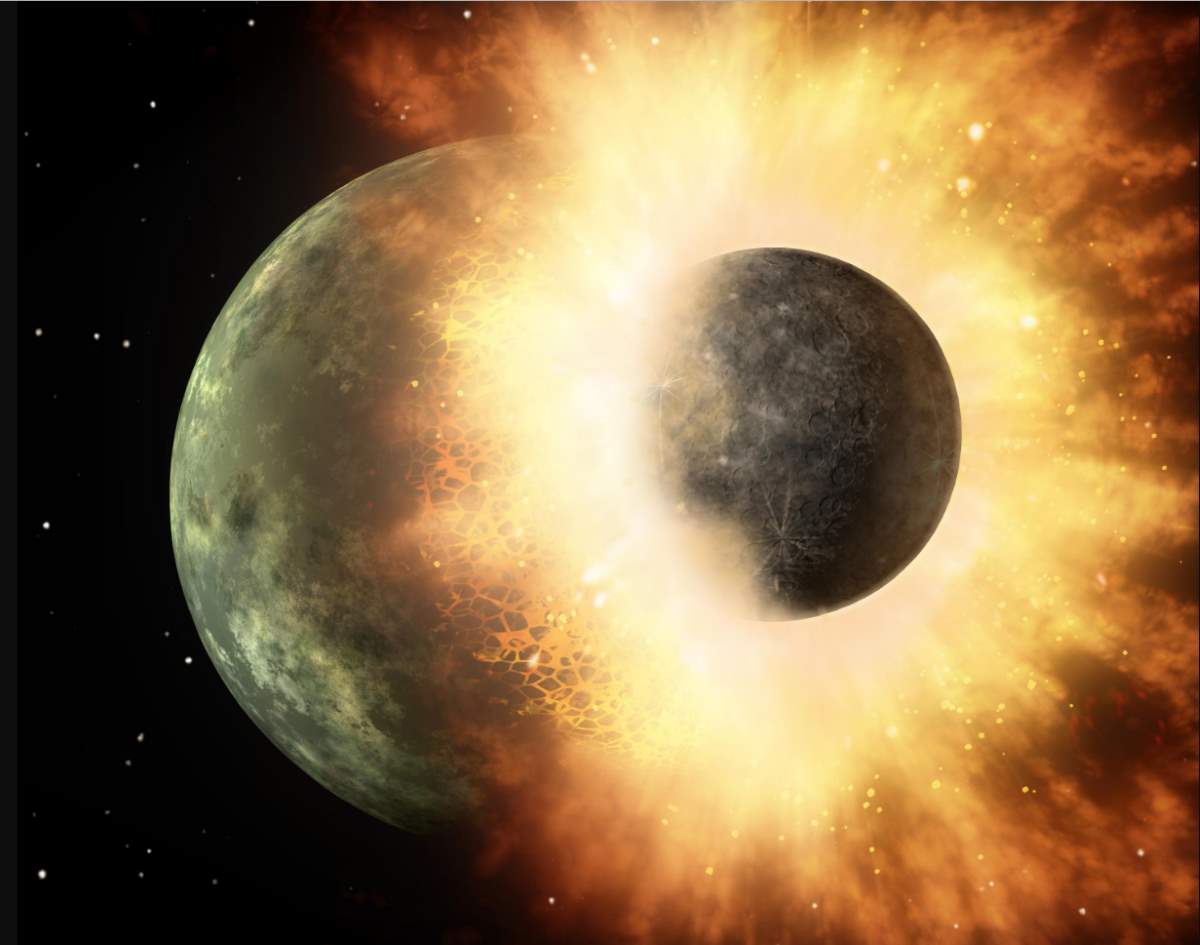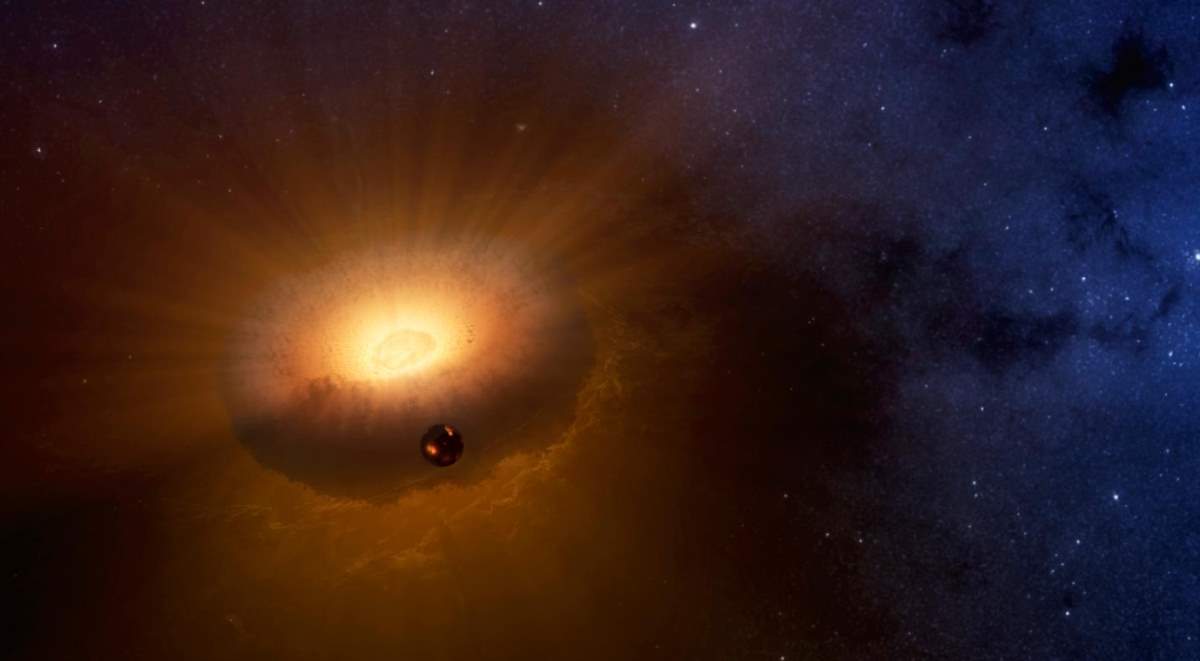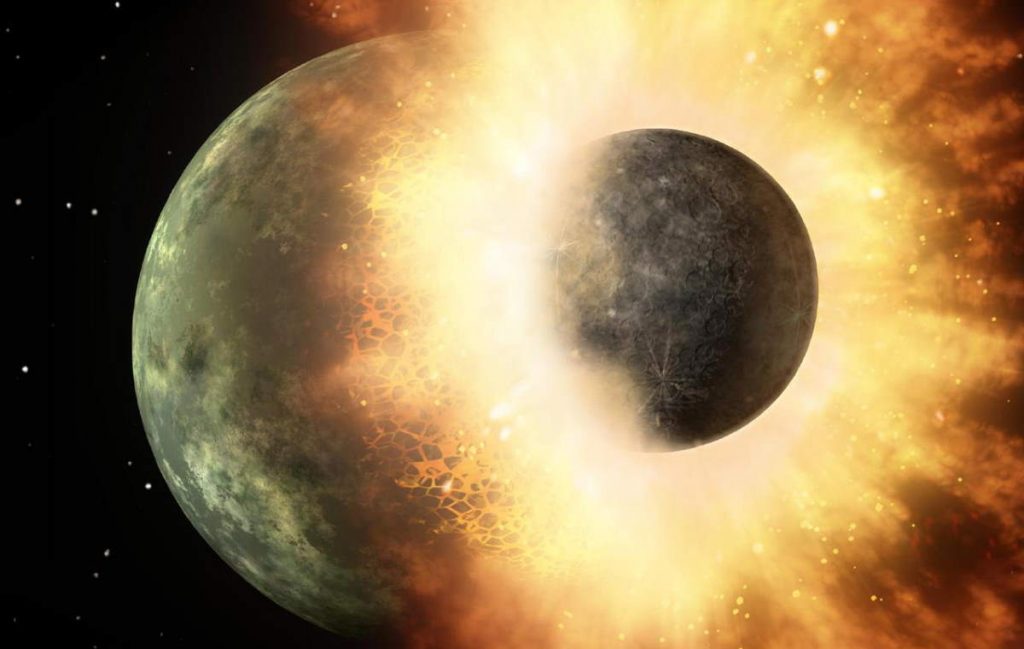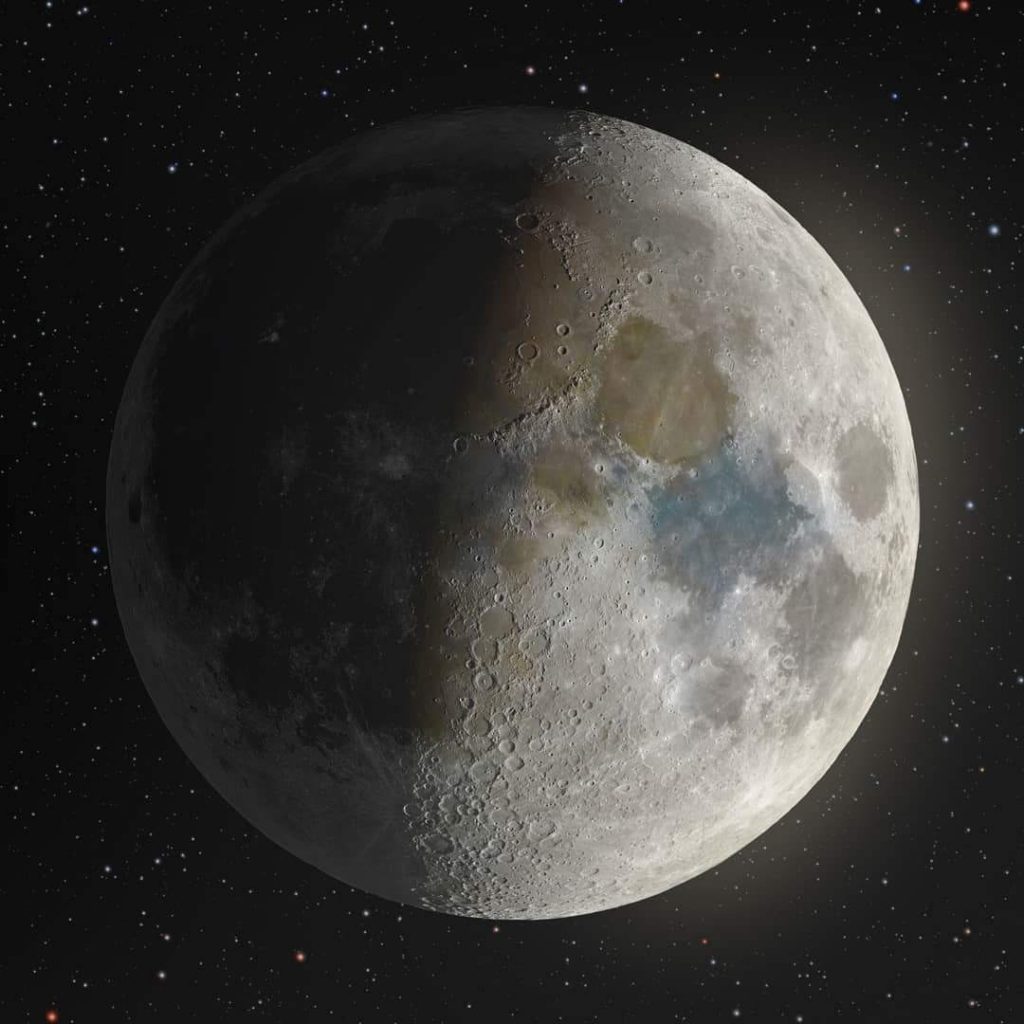According to a new study, the Moon might have been formed a thousand years earlier than Earth. The new “synestia theory” suggests a Mars-sized object smashed into the proto-Earth. The “giant impact” vaporized about 10 percent of the rock and liquefied the rest, and created a rapidly spinning donut-shaped mass of vaporized rock called “synestia”. The synestia eventually shrunk and cooled. Computer models demonstrated that the Earth subsequently emerged about 1,000 years after the moon.
Giant impact: a troubled theory
Currently, the most accepted hypothesis about the origin of the Moon is the “giant impact Hypothesis”. The standard giant impact hypothesis, sometimes called the Big Splash, or the Theia Impact suggests the Mars-sized body, called Theia, impacted Earth, creating a large debris ring around Earth, and the Moon formed out of that debris. The hypothesis additionally suggests that this collision also resulted in the 23.5° tilted axis of the earth, thus causing the seasons.

Giant-impact supporting evidence includes:
- Earth’s spin and the Moon’s orbit have similar orientations.
- Moon samples indicate that the Moon’s surface was once molten.
- The Moon has a relatively small iron core.
- The Moon has a lower density than Earth.
- Evidence exists of similar collisions in other star systems (that result in debris disks).
- Giant collisions are consistent with the leading theories of the formation of the Solar System.
- The stable-isotope ratios of lunar and terrestrial rock are identical, implying a common origin.
But, there’s a problem in the last item: if Theia hit Earth and the Moon formed out of the debris leftover from a collision, it should contain also Theia-type material. But the moon looks almost exactly like Earth, down to its atoms.
A terrestrial synestia and formation of the Moon
The researchers say that “the giant impact hypothesis remains the leading theory for lunar origin. However, current models struggle to explain the Moon’s composition and isotopic similarity with Earth. Here we present a new lunar origin model.”.
The new model relies instead on a new type of planetary object. According to a paper published last year, by Harvard graduate student Simon Lock and UC Davis planetary scientist Sarah Stewart, high-energy, high-angular momentum giant impacts create a new type of planetary object called synestia.
A synestia is a rapidly spinning donut-shaped mass of vaporized rock. In computer simulations of giant impacts of rotating objects, a synestia can form if the total angular momentum is greater than the co-rotational limit. Beyond the co-rotational limit, the velocity at the equator of a body would exceed the orbital velocity. In a synestia this results in an inner region rotating at a single rate with a loosely connected torus orbiting beyond it.

From the abstract of the study:
“During the end stage of planet formation, planets collide together and produce bodies that are partially vaporized and rapidly rotating. In this work, we developed new techniques to calculate the shape and internal pressures of hot, rotating, Earth-like planets. We find that rocky planets can have a variety of shapes and sizes. In addition, for certain combinations of thermal energy and rotation rate, a planet cannot rotate as if it were a solid body.”
“Beyond this corotation limit, the planet has an inner region that is rotating at a single rate connected to a disk-like outer region with orbital velocities. The dynamics of this extended structure are significantly different than a normal planet, so we gave the extended structure a name: a synestia. We show that rocky planets are vaporized multiple times during their formation and are likely to form synestias. The different structures of hot, rotating planets change our understanding of multiple aspects of planet formation, including the origin of our Moon.”
The new Moon formation theory suggests a giant collision smashed into the proto-Earth, instead of the Earth itself. This collision, by vaporizing about 10 percent of the rock and liquefying the rest, created a synestia. Once the terrestrial synestia formed, chunks of molten rock injected into orbit during the impact formed the seed for the Moon. Vaporized silicate rock condensed at the surface of the synestia and rained onto the proto-Moon, while the Earth-synestia itself gradually shrank.
Eventually, the Moon would have emerged from the clouds of the synestia trailing its own atmosphere of rock vapor. The Moon inherited its composition from the Earth, but because it formed at high temperatures it lost the volatile (see notes 1) (easily vaporized) elements and compounds, such as hydrogen, explaining the Moon’s distinct composition.
A synestia does not last very long – probably only hundreds of years. Maybe that’s why we haven’t observed an, yet. They shrink rapidly as they radiate heat, causing rock vapor to condense into liquid, finally collapsing into a molten planet. They might be found in other solar systems once astronomers start looking for them alongside rocky planets and gas giants.
Notes
- In planetary science, volatiles are the group of chemical elements and chemical compounds with low boiling points that are associated with a planet’s or moon’s crust or atmosphere. Examples include nitrogen, water, carbon dioxide, ammonia, hydrogen, methane and sulfur dioxide. In astrogeology, these compounds, in their solid state, often comprise large proportions of the crusts of moons and dwarf planets.
Sources
- Study: “The origin of the Moon within a terrestrial
synestia “. Simon J. Lock, Sarah T. Stewart, Michail I. Petaev, Zoë M. Leinhardt, Mia T. Mace, Stein B. Jacobsen, Matija Ćuk. Published on February 28,2018 on the Journal of Geophysical Research. - “First the Moon, Then Earth: New Theory Reverses Formation Story” by Elizabeth Howell on Space.com
- “Scientists Have a Crazy New Hypothesis About The Origin of The Moon” on Science Alert
- “
Synestia , a New Type of Planetary Object” on UC Davis web site - “The moon formed inside a vaporized Earth
synestia ” on Science Daily Synestia on Wikipedia- Giant-impact hypothesis on Wikipedia
- Origin of the Moon on Wikipedia
- Study: The structure of terrestrial bodies: Impact heating, corotation limits, and
synestias . By mon J. Lock and Sarah T. Stewart. Published on May 22, 2017 on Journal of Geophysical Research. - “What Made the Moon? New Ideas Try to Rescue a Troubled Theory” on quantamagazine.org
- “The Moon Formed Inside A Vaporized Earth
Synestia ” on astrobio.net
- How Many Elephants are Left in the World in 2025? - August 17, 2025
- Moon Landings: All-Time List [1966-2025] - February 2, 2025
- What Is Max-Q and Why Is It Important During Rocket Launches? - January 16, 2025

